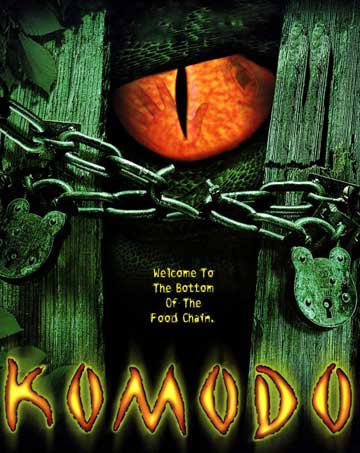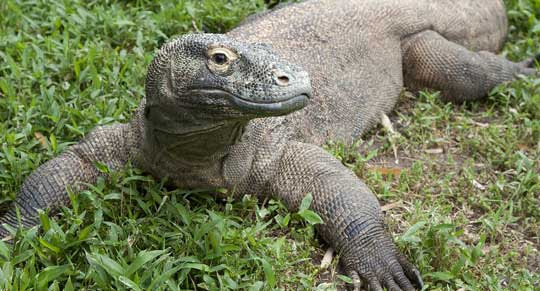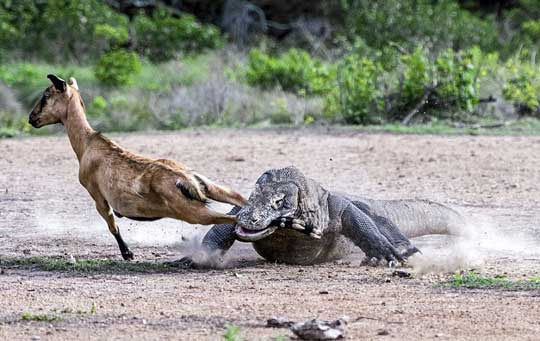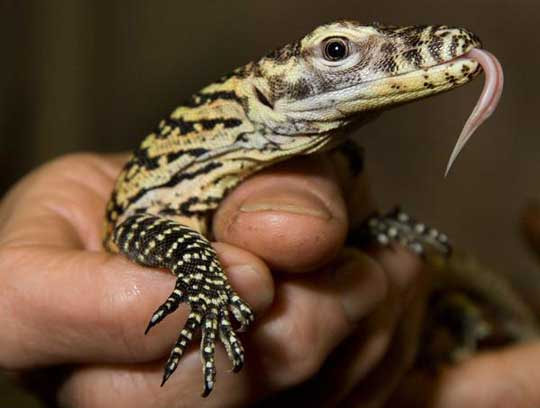|
I have a confession to make—I love creature movies (often called creature features). There, I said it. Any movie in which some rampaging creature causes terror and havoc. Of course, many of these movies are beyond silly, and they portray the creatures in a falsely-negative light (an extreme version of this was a 2006 movie about killer sheep, called Black Sheep). But I don't care how silly these movies are. I still like them. One of my favorites is the 1999 film, Komodo, with its over-the-top punchline: Welcome to the bottom of the food chain. This movie, of course, is about Komodo dragons--really mean, hungry ones. But let's face it, Komodo dragons are just lizards. Sure, they are the largest and heaviest lizards alive today, and they have a venomous bite (kind of). But are they really that bad? Let's look at the truth about these creatures. So, what the heck is a Komodo Dragon? Komodo dragons are lizards in the monitor family (Varanidae). They are found on several Indonesian islands, including the island of Komodo. They are carnivores but don't hesitate to eat carrion. Growing up to ten feet (3.1m) long and weighing up to 366 pounds (166kg), they are by far the largest living lizards. Amazing facts about Komodo dragons The most obvious amazing characteristic is their size. There are two primary lines of thought regarding this. First, some scientists say this is an example of island gigantism. This is when animals isolated on islands tend to grow much larger than their relatives on the mainland. There are hundreds of examples of island gigantism, including giant shrews and rats, kiwis and other flightless birds, and various reptiles. Here's an explanation: small islands are usually devoid of large predatory mammals (often because small islands don't have enough food to support large warm-blooded predators that need more food than cold-blooded predators). In the absence of large predatory mammals, the smaller cold-blooded predators (such as lizards and snakes) can gradually become larger to fill that particular niche. But... some scientists think that Komodo dragons are NOT examples of island gigantism. They point out that very large monitor lizards were already living on the mainland of Australia. In fact, some of the mainland lizards were much larger. One extinct species, the giant goanna, grew to 18 feet (5.5 m) and weighed 1,268 pounds (575 kg)! So, these scientists suggest that Komodo dragons are large simply because they are descended from large ancestors. Regardless of how they got that way, Komodo dragons are impressively large lizards. Komodo dragons were not documented by scientists until 1910. A few collected skins of these lizards made their way to scientists, who were fascinated by the creatures' size. In 1926, W. Douglas Burden organized an expedition to Komodo island, mainly because of the reports of Komodo dragons. After the expedition returned with several preserved specimens and two live ones, the story of the expedition inspired the 1933 movie, King Kong (a movie I still love to watch!). Are Komodo dragons really venomous? This is an interesting question, because there have been many misconceptions in the past. People used to believe that the saliva of these lizards was filled with nasty bacteria, and that once bitten, their prey would soon die and the lizards would then track them down by smell. Well, a recent study showed that Komodo dragon saliva is no different from the saliva of any other carnivore. They don't have rotting flesh stuck between their teeth, filled with dangerous bacteria. In fact, they meticulously clean their mouths for 15 minutes after eating a meal. Okay, so the saliva myth has been largely disproven. What about actual venom? In 2009, scientists identified two glands in the lower jaw and extracted the fluid from these glands. They analyzed the fluid, finding that it contained two toxic proteins known to cause symptoms such as muscle paralysis and hypothermia, which could lead to loss of consciousness in their prey. So... YES, they are venomous. BUT there's more to the story. Many scientists don't think these toxic substances have all that much to do with killing their prey. Why? Because Komodo dragons usually kill their prey very quickly. They've been observed killing wild pigs in only a few seconds. They do not bite and intentionally release their prey so that they can track them down later by smell. After all, if they already have the animal in their mouth, why let it go? Komodo dragons are often scavengers, and they can smell a dead carcass as far away as 5.9 miles (9.5km). But they also hunt live prey, and they are fierce predators. Astoundingly, they can eat up to 80% of their own body weight in one meal! When they kill larger prey (too large to swallow whole), they tear off massive chunks. They will eat as much as 88% of a carcass: the bones, hooves, some of the skin, and the internal organs, including intestines. Now here's the most amazing part. With prey up to the size of a goat, Komodo dragons can swallow the creature whole. Snakes are capable of such things, but remember, this is a lizard. To make room, they have flexible skulls and jaws. They also have an expandable stomach. Swallowing such large prey is not a quick job. It can take 20 minutes to swallow a goat, even though they have copious amounts of slick saliva to help the food go down. Check out this video of a Komodo dragon swallowing a large monkey (but only if you're not grossed out by such things) Komodo dragons have been known to try to speed up this process by running at a tree and ramming into it to push the creature down their throat. In fact, they've even been seen knocking over trees while doing this. Komodo dragons will eat just about anything they can catch, including invertebrates, snakes, other lizards, small mammals, goats, deer, horses, and water buffalo. They even eat each other. Although they can be fierce, they only occasionally attack humans. I could only find a handful of documented cases of humans being attacked. One of them was a national park guide who went into his office to sit at his desk. Unfortunately, a Komodo dragon had wandered in the open door of his office and was hiding under his desk. The guide survived but was injured. So, even though I like the 1999 movie, Komodo, the film does NOT accurately portray the true nature of these wonderful creatures. And Komodo dragons aren't always giant, fierce-looking lizards. As babies, they're actually kind of cute. So, the Komodo dragon deserves a place in the K.A.H.O.F. (Killer Animal Hall of Fame). FUN FACT: The word killer was first used in about 1525. Its original meaning was, a person or thing that kills, as in "The detective finally captured the killer." At some point it took on the meaning, something severe, powerful, or difficult, as in "That was a killer snowstorm," or "That was a killer final exam." Finally, more recently, it has come to mean, highly effective or superior, as in "That is a killer fried chicken recipe." Considering the nature of the Komodo dragon, I think this word is perfect. So, killer is another way to say awesome! Photo Credits:
Komodo Dragon #1 - Smithsonian's National Zoo Man with Komodo Dragon - Jerry Fife via Reptile Magazine Komodo Dragon attacking goat - Caters News Agency via UK Daily Mail Baby Komodo dragon - The Denver Post
0 Comments
Leave a Reply. |
Stan's Cogitations
Everyone needs a creative outlet. That's why I write. Archives
July 2024
|






 RSS Feed
RSS Feed